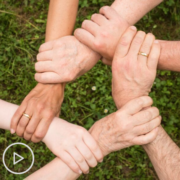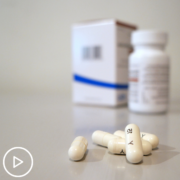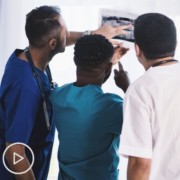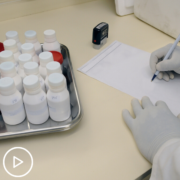How Can I Get the Best Multiple Myeloma Care No Matter Where I Live?
How Can I Get the Best Multiple Myeloma Care No Matter Where I Live? from Patient Empowerment Network on Vimeo.
“Myeloma patients who are African-American and Hispanic typically get to the right treatment much later. In a lot of cases they may not get to the right treatment at all. We also know that the burden of cost of care is much higher for minority patients.” – Dr. Sikander Ailawadhi
There is a critical need to raise awareness of the treatment gaps among minority populations living with multiple myeloma. How can myeloma patients get the best care no matter where they live when factors like age, geography, socioeconomic status, ethnicity, gender, and insurance type heavily influence the path to empowerment?
In this replay, a panel of distinguished myeloma experts and patient advocates tackle how we achieve health equity for multiple myeloma patients no matter geography.
See More From the Diverse Partners in Your Myeloma Care Program
Transcript:
Rebecca Law:
Hello, I am Rebecca Law, and this is a Patient Empowerment Network program produced by Diverse Health Hub. We know the myeloma burden and treatment gaps among blacks highlights the critical need for raising awareness and working towards equal access for treatment. What we are really talking about is, “How can we achieve health equity and improve outcomes in multiple myeloma?” Our distinguished panel is at the heart of research for multiple myeloma patients of color, seeking a path for empowerment.
First on our panel is Diahanna Vallentine, a Board-Certified Patient Advocate and Myeloma Financial Coach with Myeloma Crowd. We also have Dr. Sikander Ailawadhi, Professor of Medicine in the Division of Hematology and Oncology at Mayo Clinic in Florida. We have Dr. Saad Usmani, Chief End Plasma Cell Disorders Program Director at Levine Cancer Institute, Atrium Health. And we also have Jenny Ahlstrom, founder of Myeloma Crowd. Thank you all for being a part of such an important program Diahanna, rooting out disparities and roadblocks within the myeloma community is a big priority for you. Why is that?
Diahanna Vallentine:
Well, disparities in healthcare include community access to care, ability to pay for care, feeling empowered to ask questions about care, understanding treatment plans, and many other variables that is impossible to pin point one that’s the primary driver, I guess, of this disparity. And as a black person, having been a caregiver and advocate to my husband who had myeloma for 12, almost 13 years, prior to him being diagnosed with myeloma and then going back into the hospital for various reasons, I found that there was a huge disparity in the way that he was treated. And some of those things have led me to do what I’m doing now with the Myeloma Crowd. There was an attempt for him to be put on an experimental treatment while he was on life support, with a doctor coming into the room with other doctors saying that, “This is what we’re going to do.” And I stood up and said, “Well, what is this treatment? What is the experiment? What were the outcomes of the experiment?”
And the doctor got in my face, six inches, yelling at me, and said, “You don’t have the right to ask questions, we’ll normally do this and you’ll find out about it later.” And that was very disparaging, especially since posted on all of their walls outside and one outside of my husband’s door, was, “Families are very included in the care and treatment of their patients”, because they found the outcomes were so much better. And that was not the case. That was one incident. Another incident was him being in the hospital, in rehab, and was almost comatose when I walked into the room, and they were insisting him get rehab treatment post hospitalization.
He was basically comatose. His resting blood pressure was 172 beats per minute. And it took me hours to get the doctor to even come in to see him before they actually agreed to release him to go back into intensive care, which was only a block away. And he died during that transport, and they weren’t able to resuscitate him at the emergency room doors. So, just the ability to be able to talk to the doctors, to be strong enough, empowered enough to question the doctors, to find out what the cost of care is going to be so that you can plan and make the appropriate and prudent decisions based on care, I found was somewhat lacking in the minority population.
And it had nothing to do with the education of the patient there, sometimes it had nothing to do with their economic backgrounds or situations, it was a matter of stereotypes that were being used, sometimes unconsciously, and I hope it’s unconscious, by some of the caregivers during his treatment. And as a result of that, some of the decisions that were made were not necessarily in a financial benefit of the patient, and therefore, when treatment plans were put into place there was a cost associated with getting help… Not just financial cost, but there was a physical cost and a mental cost for getting out of those treatments to get into better treatments. And that’s led me to work with Myeloma Crowd where they’re just so open, and to trying to help people in unserved communities, specifically people of color, to have the appropriate access and to have the appropriate treatment based on their needs.
Rebecca Law:
Thank you for sharing your story. Now, Dr. Ailawadhi, for our audience who might not understand what health disparities in myeloma look like, can you give a high-level definition and overview, please?
Dr. Sikander Ailawadhi:
Sure. Thanks Rebecca, and thanks for having me on this panel. Diahanna, first of all, I think I want to take a second and really appreciate you for having the courage to share that. And not only just to share that, but to devote your life and devote your time to this extremely, extremely important cause. We keep talking about so many advancements that are happening in the field of myeloma, and by all means there are. I don’t want to discount any of those advancements and how outcomes have improved tremendously for patients across the globe. But when we start looking at the details and the nitty gritty and we see that how the benefit or the impact of a lot of those things are different even based on race and ethnicity, it’s stark. So, Rebecca, you asked me to just talk about a very high-level discussion about what kind of disparities exist in myeloma? Or what do disparities mean when it comes to multiple myeloma?
So, there are disparities at a lot of different levels, just taking the case of multiple myeloma, specifically. So, for example, patients from different racial and ethnic backgrounds tend to present in a different way. So, African-Americans present with the diagnosis at a much younger age. The presence of the myeloma precursor called MGUS, or monoclonal gammopathy of undetermined significance, is seen much more frequently in African-Americans. Even I would say include Hispanics into that, because Hispanics also get diagnosed at a much younger age. The disease presents very differently, for example, African-Americans will present much more frequently with anemia or kidney dysfunction, but they will present with much lesser bone fractures in multiple myeloma.
So those are disparities in how the disease presents or how it becomes kind of evident. Now, when we talk about disparities, one of the very stark shades of disparities in myeloma is how treatment is given or made available to patients, especially when we talk about racial minorities. So, there has been a lot of literature looking at this, and it has been seen that patients who belong to racial and ethnic minorities, they do not get access to the same kind of treatment in the same timely fashion. So, for example, African-Americans and Hispanics are much lesser likely to get a transplant when it comes to myeloma treatment. Now again, I don’t want to say that improvements have not happened. The rates of transplant, rates of new drug use, have increased across the board for all races and ethnicities, but when we compare, the rate of that increase has been much slower in African-Americans.
In fact, one of the studies that we looked at, some national data, it took Hispanics a little more than 100 days from the time of diagnosis to get to initial treatment with Bortezomib, which is a cornerstone drug and is used almost across the board for initial therapy. So, the treatment, there are disparities. And similarly, there are some outcome disparities. While on the face of analysis, it’s been said several times that races or different racial sub-groups will have similar outcomes, I think the important thing to understand is that biologically, African-Americans have a less aggressive disease, which means that if given the right kind of treatment, African-Americans are supposed to in fact have a slightly better outcome than even whites. And there’s one large analysis that came out of the VA system from the Dana-Farber group last year, which was actually highlighting that, because they were able to show that in an equal access system like the VA, African-Americans actually had better outcomes, or better survivable. So, there are disparities at the time of presentation, at the time of how treatment is received, how timely is the treatment, and in fact also, outcomes. Because I would say that having an equal outcome for a racial minority is not necessarily lack of disparity, that may actually be underscoring the disparity.
Rebecca Law:
Wow, that’s very interesting. Dr. Usmani, can you speak to key studies you and your colleagues are leading, which focus on racial inequities plaguing myeloma research, and what are some of the commonalities you observe in the studies?
Dr. Saad Usmani:
Thank you, Rebecca. So, I want to acknowledge the fact that we’re getting this panel together to talk about some very important difficult questions when it comes to racial disparities here. And when I moved from the myeloma program in Arkansas to the City of Charlotte to start a myeloma program, one of the striking things that we saw was the proportion of African-American patients that we were seeing in our practice, almost 35% of the patients that we care for in our myeloma program are African-American. And before we came here, when we looked at the data beforehand out in the community, there was clearly disparity in access to care, as well as to cellular therapies, as well as clinical trials to African-American patients. So, within our whole department of hematology, across the board, not just for myeloma but for other hemalignancies, looking at racial disparities and how to overcome them became one of the big clinical research foresights.
And so, our group, as well as lymphoma and leukemia colleagues, have actually looked at the survival outcomes, the disease features at baseline and other features to document the clinical characteristics within our population. And I echo what Sikander has already mentioned, that we find that the disease appears to be less biologically aggressive in African-American patients, and when we give them the same access to care, their outcomes are actually better than the Caucasian patients. And I believe Sikander has already published some data looking at the SEER database from previous years, but in their novel therapies with the availability of produce from inhibition, immunomodulatory drugs, as well as monoclonal antibodies, we’re finding this difference is pretty clear. African-American patients do benefit more than other groups when it comes to myeloma therapy. So, our ongoing focus now within our community at large is to embark on an ambitious screening study for our county, which has close to 3 million inhabitants, and more than 30% of those are African-Americans. So, what we are trying to do is create a campaign of awareness, as well as start a screening project to identify plasma cell disorders early within our county.
Rebecca Law:
Well, that’s great. Dr. Ailawadhi, if there’s anything you’d like to add in regards to studies or commonalities that you have observed in studies.
Dr. Sikander Ailawadhi:
Rebecca, one thing I want to add to that, and just like Dr. Usmani mentioned, and I’m also kind of building upon a little bit on what Diahanna mentioned in the beginning. When we talk about disparities, there has been a lot of literature showing how disparities exist and where they exist. I think now we’re to the point that we need to try to address them, and we need to try and figure out how to overcome them. And in fact, whenever this term is brought up in the literature or in discussions, it’s always brought up very frequently, “Yeah, it’s got to be an access issue”, that African-Americans or Hispanics are going to be lower socioeconomic status and there could be inequalities and that’s why they don’t have access to the right treatment. But I think what Diahanna just mentioned at the beginning of the discussion, that underscores that very thing. They did not have lack of understanding, they did not have maybe lack of insurance or healthcare availability, ’cause her husband did have access to rehab facility, ICU, etc. But there are probably stereotypes, and the last thing we want to do is stereotype our research into that box.
So, for example, one of the studies we’re doing right now is exactly on this thought process of clinical trial and participation. So, we know that in the US, less than 20% of individuals who are eligible to go onto clinical trials, go onto clinical trials. And when it comes to minorities, the number is somewhere about 5%-7% only. So, while we talk about the fact that, “Well, minorities need to get onto clinical trials”, yeah, sure, but we need to understand why this disparity exists. So, we’re doing a study where we’re actually bringing that understanding to try and see, “Well, why don’t patients want to go on clinical trials?” I mean, as it is, even with whites, we do a pretty dismal job. So, we’re doing a questionnaire. The goal of that is to run the questionnaire in about 500 cancer patients who come to Mayo Clinic as an initial kind of visit, and we’re asking them what are their thoughts about clinical trials. And the hope is that we’re going to get about 200 whites, 150 African-Americans and 150 Hispanics, and then try to compare that. Because unless and until we know where the gaps are, we won’t be able to address that.
So, the only thing I want to add to what Dr. Usmani rightly mentioned was that it’s important not to box our research also in stereotypes, and to really try our best to try and overcome these disparities, which I think a movement has already started. I think it is gaining momentum. I think we need to just keep working in that direction, whether it is from lawmakers, from patient advocacy groups, from large foundations and societies, and even from pharma. I think there is a lot of support that is building towards it, we just need to keep moving in that direction.
Rebecca Law:
I agree. I think we all agree Dr. Ailawadhi or Dr. Usmani, what do we know about how myeloma behaves in patients of color versus other races? Are there differences in risk factors? And if yes, what do we know?
Dr. Sikander Ailawadhi:
So, Rebecca, what we have learned from studying myeloma and its precursor diagnosis, MGUS, in African-Americans and Hispanics and Whites is that in African-Americans MGUS presents much more frequently. In African-Americans, the conversion from MGUS to myeloma happens at a younger age. In African-Americans, myeloma is diagnosed at a significantly younger age. And for that matter, I would say also in Hispanics it is diagnosed at a significantly younger age. We know that in African-Americans, the myeloma risk stratification or the risk category is different because African-Americans, in general, have a less aggressive kind of variety of multiple myeloma so they tend not to have the high-risk mutations, which means that if they are given the similar treatments, we should be getting better outcomes, not just the same. So that is what is known about the biology and presentation.
Dr. Saad Usmani:
Yeah. So, in addition to what Dr. Ailawadhi has already mentioned, I’d say that in our experience, within our prospective data base we have close to 5000 individuals with various plasma cell disorders, and a third of those are African-American. For patients who’ve got active myeloma, I would echo what Sikander has already mentioned, African-American patients are presenting at a younger age. So, we see in our database a median of 58 years of age at the time of diagnosis with active myeloma requiring therapy, compared to 63 years for the Caucasian patients. And then even Hispanics are presenting at a similar age to the Caucasian patients, at least in our data set. But interestingly, we see a numerically lower incidence of high-risk features in these patients, and they do quite well in terms of treatment.
And the pattern of relapse is also very interesting. We are finding more biochemical relapses where we actually have time to act on that relapse, and with some luxury of time at hand, and get those patients to either clinical trials with much ease compared to the Caucasian patient population. And then I want to build on the availability of clinical trial piece that Sikander had mentioned. We have, at our program, been able to get a 30% plus enrollment of African-American patients on clinical trials. And a big part of that has been creating awareness about disease, about getting diagnosed early, within the community and building those community partnerships.
Rebecca Law:
Jenny Ahlstrom, thank you again for joining us. I have a question for you. So, in the COVID era where health disparities have been exacerbated for vulnerable communities, how can myeloma patients not get lost in the shuffle and become a disparity within a disparity?
Jenny Ahlstrom:
I think this is a big challenge. I think it’s a challenge for myeloma patients, and I think the first two months we were all stunned. From what I’ve heard now, the facilities and the myeloma specialists are doing an incredible job now in treating patients. But we wanted to know what the impact was on COVID in the myeloma population, including racial disparity groups. And so, we opened a study using our HealthTree platform for — I think we have 1100 patients who joined the study in a four-week period, which I was surprised and delighted at. And we’re trying to figure out, “How were they impacted? Did they have worse access to care? Who are the high-risk patients?”
I think that’s a topic that is really important, especially when you think about Black or Hispanic communities, because is it just that somebody has hypertension or diabetes regardless of race? Or is it something else that’s another layer on top of an access issue, or what Diahanna was talking about before? Just somebody, a practitioner, taking somebody seriously when they say they come in with COVID symptoms and needing the right care regardless of race. So, we decided to run that study and we’re working on the results right now to just learn more about that. But it does… COVID adds another layer of challenge for all patients, and I think even more so for the disparity groups. And that can include rural groups as well, in addition to ethic communities.
Rebecca Law:
Well, I can’t wait to see those results, and thank you for that information. What I would like to shift to now is exactly what you were talking about, myeloma care in underserved communities, and eliminating treatment gaps. So Diahanna, we know many of the roadblocks to treatment boil down to access and the web of financial toxicity. In the work you do, how are you helping patients make informed decisions, and can you please provide some examples?
Diahanna Vallentine:
I think one of the main variables that causes the disparity overall before even treatment is needed is a mistrust in the African-American community as a result of past historical treatments, experiments that were done on the African-Americans. And I find that talking to anyone… If I were to walk into any community, African-American community, or under-served community, that is one of the first things. They’re going to be mistrustful of me. And it’s a very difficult barrier to overcome. And that also leads over into African-Americans contributing, being donors, African-Americans participating in trials. It all feeds over into everything that’s done in the African-American community or underserved community in regards to health care.
Some of the things that I am doing is I try to be available to talk to anybody, no matter what time of day it is, talk to them where they’re wanting… Where their needs are, listening to them and not making pre-conceived notions about who they are, where they come from, what their experiences are. And that has been one of the things that I have been practicing every day when I talk to patients, whether it’s in person or on the phone. I have a unique perspective having been a financial advisor for more than 20 years, being a caregiver to a myeloma patient, being a patient advocate and not having the fear… I guess that’s something I grew up with. Not having the fear to talk to people or ask people questions, and let them know from the on-go that we all have something in common.
And once you establish that area of trust, then everything else comes easy. When you realize that that could be me in that bed, that could be my mother, my father in that bed, then we all become as one, per se. And so, some of the things that I do is I talk to a person at the level they want to be spoken to. I ask them how they want me to communicate with them, how often they want me to communicate with them, is there anyone else they want to be involved in it. And then I take that information that they’re trying to gather and find resources for them so that financial toxicity will not become an issue, so that we can discuss with their caregivers what the treatment plan is, what the anticipated cost is, so that we can work around some of those financial barriers that they may come up against. And whether that’s looking at their current insurance plans, insurance plans they may have access to in the future, whether it’s through a spouse or their employers, or Medicare, Medicaid. We try to anticipate what those things are so that the financial toxicity does not become a burden, which again, affects their care, because stress affects your care and your outcomes.
25:21
Rebecca Law:
Absolutely. Absolutely. Also, Diahanna, what do you see as some of the main drivers of health disparities in targeting the underserved communities?
Diahanna Vallentine:
Wow. That’s a big one. That’s one of the things that… I don’t know if there is enough knowledge in the underserved communities to know what resources are available. A lot of people have not heard of The Myeloma Crowd. A lot of people are not aware of The Leukemia and Lymphoma Society because, unfortunately, I felt that myeloma was a step child of The Leukemia and Lymphoma Society because that’s all you heard about, was leukemia and lymphoma. You never heard about the myeloma. And when I became the board chair, I realized, “Oh my God, there’s that other blood cancer out there that nobody’s talking about, the one that my husband actually succumbed to.” So, I think getting into the community so people can… Where they are, not where we expect them to be, but where these people actually are, to let them know there are resources available to them. And making it an open environment, a non-transparent environment where the trust will come and that those disparities can be seen and they can be acknowledged and worked on at that point.
Rebecca Law:
Great, thank you. The other question, and anyone can chime in. You hear stories all the time like what Diahanna described earlier. Can patients truly get the best myeloma care no matter where they live?
Diahanna Vallentine:
I found that even people who are in regions where there are specialists for myeloma found that they didn’t know there were specialists there or they had to go travel outside of their treatment facility to get care. And for some people, that is an extreme hardship not only to be able to have the access to travel, the funds just to be there, the days of testing that might be involved, understanding what their insurance is going to cover or won’t cover if they’re in or out of network. There is a huge problem with that. There aren’t enough… I don’t think there is enough information in the places where those people are, whether it’s the doctors allowing this information to be in their plan. Unfortunately, a lot of African-Americans, when they do seek medical care, they’re comfortable with those doctors. They’ve been with those doctors for a long time and they have a difficult time separating or using that doctor to collaborate with a specialist. And I think therein is an inherent problem, is letting them know what resources are available, and then how to get to those resources.
Dr. Saad Usmani:
So, I want to build on what Diahanna has shared. I think in general, in the year 2020, there are more resources available to myeloma patients across the country. There’s more awareness by virtue of having organizations like The Myeloma Crowd doing good work and spreading knowledge amongst the myeloma patient community, as well as for caregivers. There’re aren’t enough myeloma experts in the world to see every myeloma patient, but there’s no reason why any given myeloma patient regardless of which geographic area they live in can’t have a myeloma expert in their back pocket, if and when they need help. It takes quite a bit for a patient to develop trust and a relationship with their own physician. And our job as myeloma experts is not to take care of every myeloma patient, but be there for them and provide guidance if and when needed, along with the physicians who are already caring for that patient. And in the era of COVID-19 pandemic, and Dr. Ailawadhi can speak to this as well, the capability to do virtual consultations and provide distance consults and advice to patients has also opened up a big opportunity for patients throughout the country. I do not see a reason why all myeloma patients can’t get the best optimal care in today’s day and age.
Dr. Sikander Ailawadhi:
I completely agree with that. And actually, I was going to add exactly the same thought process, that this is a very difficult time for everybody, myeloma patients and for literally the whole of this world with the COVID-19 situation. But I think this whole concept of telehealth has come about as somewhat of a silver lining. So I can tell you, I can share from at least my experience right now in clinic, that when we get a request for a patient to be seen, the way we have it set up is that actually a triage request comes for one of us in the disease group to confirm that the patient is actually coming to the right physician. So if, let’s say, someone by mistake may have said myeloma, but the patient has leukemia, then one of our job would be to make sure that rather than coming in and then the patient finding out that, “Hey, you are with the wrong doctor”, they end up seeing the right doctor even from get-go. So, when we’re doing these triage requests and we’re sorting them out, patients are actually reaching out and asking directly, saying, “Hey, I would like another opinion. I’ve been told I have a diagnosis of myeloma or smoldering myeloma or MGUS or something, I’m going to be sending in my records and I would like to do a virtual consult.”
And so, patients are actually reaching out that way, which gives us this opportunity that, “Hey, not everybody can come here, let alone the fact that we cannot accommodate.” And I’m not even going get to the point of we not being able to accommodate. We’re doctors, we’re institutions, health care workers… This is our job, to help as much as we can. But looking at it from the patient’s perspective, the patient cannot always have the resources to come. It’s not appropriate for us to expect, “Hey, we’ll build a hospital, you’ll have to come here.” I think in today’s day and age, when we can do so much more with technology, it’s… Healthcare was actually in some way lagging behind, but I’m glad that it’s coming up to that step. So, to be able to get the patients to get the consult, to get the opinion, to get that reassurance that what they are doing, what they’re getting in their area, in their community is actually right, because I can tell you and I think Dr. Usmani will agree with that, that nine out of 10 times, we actually fully agree with what’s being done for the patient or by the physicians, it’s just that they may not have access to a clinical trial, so they’re seeking it or the patient is just looking in for that reassurance.
So, I think now we have that opportunity to provide it for the patient. So, what we need is awareness, so that the patients, like Diahanna mentioned, they feel confident about asking for an opinion, asking for a consult and knowing that they have resources where Myeloma Crowd helps, where Leukemia Lymphoma Society helps, where International Myeloma Foundation helps, where they kind of bridge this knowledge gap. Once the patients know… It’s easier said than done to say, “Hey, be your own advocate.” But if a patient or a caregiver does not know what advocacy is, they’re not going ask the right questions. So, we need to educate them and we have the tools that we can help more patients across the world, across the country, and bring the advancements of myeloma care to everyone.
Jenny Ahlstrom:
Dr. Ailawadhi, I think that point is so important, and Diahanna referred to it earlier. Let me give you an example. So, we went across the country and visited 50 cities while we were building this HealthTree platform, we probably met with 850 patients. And we wanted to see all ethnic communities, all rural, big cities. We just wanted to see across the board what was happening. And as part of that, we met a woman named Cassandra. She had smoldering myeloma, she had severe back pain, she was just enduring this back pain for over a year. And because we met and we built that relationship, that one-on-one relationship, she felt comfortable calling me and saying, “I have this really severe back pain, what do I do about it?” She didn’t know that… She was going to a major cancer center, but no myeloma specialist necessarily, and I had to say, “What you’re enduring is inexcusable, you really need to push.” And she had been pushing, but she didn’t really know how.
So, I set her up with an appointment with a myeloma specialist that was just an hour drive away, and then she was able to get the proper care. So sometimes it’s this training of, “How are you an advocate? What education do you need to acquire so you can ask the right questions of your doctor? You should be seeing a specialist; how does that process work?” And just really walking the patients through this, because it’s confusing and they don’t feel good, and there is a lot. So, it’s really important, the points that both of you made.
Rebecca Law:
Yes, it is. Going back to telemedicine, do you guys think telemedicine will be a game changer for underserved communities, especially patients facing a myeloma diagnosis?
Jenny Ahlstrom:
I say yes. Completely.
So, in our study, we saw that, we asked that question, “Did you use telemedicine beforehand?” And either they said yes or sometimes, and it was at 9% prior to COVID, and then after COVID it’s at 60%. So, patients are using it, and I’m hearing some of the researchers, and I’m sure they’ll have their own experiences, say, “We never realized how much we could do via telehealth.”
Dr. Saad Usmani:
So, this is a time of innovation. I think we’ve seen a lot of innovative approaches to taking care of patients come about over the last four months. One of the limiting steps in doing virtual medicine however, is the reality that it does require insurance coverage. And so, Medicaid allows the virtual visits to be a billable service during the COVID pandemic, but I think right now there’s a push to reverse that ruling by the end of August. So, it will take a lot of partnership between patient support group organizations to actually push for this, because there’s no reason why you want to go back to the dark ages. You want to have these platforms available to provide better care for patients. It just opens up so many possibilities of providing optimal care to patients, especially in the remote areas. So, I think this is going to be a very active area of discussion, and will require engagement with legislature on parts of both physician organizations as well as patient organizations.
Rebecca Law:
Okay, let’s move on to disparities and its impact on myeloma clinical trial participation. So, Dr. Ailawadhi, the demographic in America is changing quite rapidly, does this mean clinical trial participation is more critical than ever?
Dr. Sikander Ailawadhi:
It absolutely is, Rebecca. There is no way to kind of shine enough of a bright light on this topic. And I’m glad that we’re talking about it. There is more interest and also more thought process being put behind it. So, you’re right in saying that the demographics are changing quite a bit. So, we don’t know how and when we’ll get all the 2020 census data; but over the past few years, census bureau has been releasing updates where we know that Hispanics are the fastest growing racial ethnic group in the country and followed by Asians. And African-Americans are already a huge part of our demographic. So whatever we’ve discussed before when we said that patients can present at different ages, they can present with different symptoms, we also know from our experience of other diseases like hypertension, high blood pressure, diabetes, that the way certain drugs are metabolized could be inherently genetically different between, let’s say, African-Americans and Whites.
Unfortunately, in myeloma, we don’t know any of that because clinical trial participation overall in cancer and also especially in myeloma, in a disease where African-Americans may be affected by this diagnosis way more, the clinical trial participation is extremely low, in single digits. Which means that all the drugs that we utilize are FDA-approved, have become FDA-approved with not enough safety or benefit data in racial ethnic minorities. Now, I’m not saying that there is any problem in using those drugs; we use them, they benefit patients outrightly. But I think that underscores the importance that clinical trial data and generating robust safety and benefit data in all racial ethnic groups, considering that our demographic 10 years from today is not going to be what it is now or what it was 10 years ago. So, understanding the dynamics of drugs, their impact, their benefit, their safety, in all racial ethnic groups becomes extremely important. And that can only be done when either clinical trials are specifically done in those populations, which, as Diahanna mentioned very well, appropriately before, it’s a very challenging thing because there has been a traditional lack of trust there. So, it becomes very important.
I can tell you that I had mentioned earlier that we’re doing a questionnaire just to understand why patients don’t want to go on clinical trials, or do they not want to go on. It’s just maybe, it’s access issue. And I distinctly remember… I cannot take an anecdotal look at it because I’m a clinician, I’m a researcher, I’m not supposed to look at the end of one. But I’ve had at least two specific cases where newly diagnosed multiple myeloma African-American patients who’ve come, and I’ve very clearly explained to them that I’m just wanting them to consider going on this study with a one-time questionnaire. No samples, no bone marrows, no treatment, no nothing. All I want to understand is what they think about clinical trials. It’s a five-page questionnaire, 50 questions, multiple choices. We’re not taking any other data. Both these patients took the… They signed the consent, so they took the questionnaire. They took it home; we could do it electronically but they said they wanted to think about it.
And for both these patients, they called back and they said, “You know what? I don’t feel comfortable with going on a clinical trial even though it’s a one-time questionnaire. I’m going to kind of respectfully decline.” And I initially could not understand the whole thought process because it seemed, “Well, it’s just a questionnaire. We do so many surveys online.” But I’ve talked to them several times since then, and the thought process, which Diahanna brought, up about that lack of trust, that came out loud and clear. These patients are still receiving their treatment with us because initially there were concerns, they said, “Well, if I don’t do the questionnaire maybe this doctor won’t treat me.” They’re receiving their treatment with us, they are continuing, we’re good, we have a very good relationship, but they decided not to go on those. So, I think clinical trial participation is extremely important, especially because of the changing demographics, like you said.
Rebecca Law:
Jenny, so many experts try to tackle this problem. What are organizations like Myeloma Crowd doing to open up access to those who have access issues?
Jenny Ahlstrom:
Well, I think this is a very common problem, and one I think a lot of the different foundations are working on. It’s a big challenge, as you heard. Like when we were talking about the clinical trial aspects, it’s hard to join a clinical trial regardless of your race, and then you layer on the trust issues or travel or those types of issues and it becomes even harder. I think we need to go back to what Diahanna said. To me, this is all about relationships. So, if you’re building solid on-the-ground relationships with individuals, they’re more likely to understand the importance of becoming your own advocate or getting educated about the disease so you can ask the right questions. We’re trying to build a lot of different tools for patients to use, but then you need to go back and invite them to use them or kind of teach them to use them because you have that relationship. So, for example, we’re building HealthTree University, where Dr. Usmani and many others, and Dr. Ailawadhi, hopefully you as well, will participate in teaching myeloma patients about multiple myeloma. So, we have over 30 classes planned, over 600 lessons. And that’s something that people would be able to go and get educated about myeloma at home, so that when they go to the clinic and are talking to their doctor, they start to ask better questions. So, that is kind of the beginning.
Rebecca Law:
Dr. Usmani, as you can see by turning on any news station, racism is very real in the US. Do you think some experts may be less willing to give patients state-of-the-art treatment, given they feel they have a special resilience?
Dr. Saad Usmani:
I think the racism question, it’s certainly at the top of our minds right now, especially in the context of recent events. But it has been inherently prevalent, and there’s been more of a divide in our country over the last five to six years. And I don’t want to get too political, but the bottom line is this issue is real. And for the most part, the physician community tends to be agnostic to it because with our job is to serve humanity, our job is to provide the best possible care. There are going to be, just like in any other profession, average, above average and exceptional physicians.
Diahanna Vallentine:
I have experienced it in my family with my husband, and I have been in hospital as an advocate watching other people experience the same thing. And one of the prevailing things that’s really surprising to me is that even in a educational setting in medical schools, there are a lot of physicians in training, and physicians that are practicing, believe that African-Americans do not have the pain, their skin is too thick, they don’t experience pain as other Caucasians may experience, and therefore may not be prescribed pain medicine as appropriate. And that could become very, very difficult, especially if you’re treating a chronic and sometimes a very painful disease as myeloma, with bone fractures and things. And so, their health outcomes, I think, are somewhat mitigated or lessened as a result of that type of treatment. My husband did experience that, and it became very difficult for us to finally get a physician to say, “Yes, he does have… Yes, there is a fracture, a multiple fracture. And there is bone pain associated, and aspirin and Tylenol is just not going be enough to manage his pain.” And I’ve witnessed that on several occasions with other people as well. So that is an ongoing problem. When we talk about disparities in access to, or getting into the community, I think one of the predominant problems is African-Americans and maybe people of color will be more likely to associate people that they relate to.
And that person of relation may be another African-American, a professional maybe in a community that can talk to them. Because now they see a face that looks like them. They have a face that may have experienced some of the same things they are going through, and they are open and willing to accept recommendations or information from people that they can relate to. And I think a lot of professional communities do not have that available, whether it’s through lack of education for minorities to be in positions like that, or just a lack of understanding what the actual community needs are.
Rebecca Law:
We tackled a big topic today, and as I close, I want to ask each of you to answer a question. So how can we achieve health equity in the care of multiple myeloma patients sooner rather than later?
Diahanna Vallentine:
I think we all appreciate the fact that the African-American or underserved communities do not have enough people that are either willing or know that we need to go into those communities the way they are, meet the people the way they are, so that we can provide them with education, with resources, that are available. I think that is one of the first steps. And fortunately, or unfortunately, with the racial problems we’re having in our country right now, a lot of governors and mayors are opening up opportunities that we got to get into the communities. And I think this might be a great opportunity for the myeloma community to perhaps step up and say we would like to be presented or represented in the community when there are funds and when the interest is really high. I think that if we could establish a foot-hold that way, then we can just go on and work toward lessening that gap and disparities in the undeserved communities.
Sikander Ailawadhi:
Diahanna, that was really nicely put. I think what I can add to that is that we basically are already seeing a lot more discussion, a lot more focus coming up to this topic of racial disparity in multiple myeloma at different levels. So, what we need to do is continue to build upon that momentum, continue to build the relationships so that there is actually a combined force from various aspects. I would love to do telehealth going forward, but like Dr. Usmani brought up, if there is not enough reimbursement or leadership or legislation to support all of that, then our wants and needs may not be served fully. So, I think developing those relationships, developing those partnerships and moving forward as we’re gaining momentum to address this particular question, this particular issue is extremely important. And I feel it is more hopeful and exciting in the future as compared to where we’ve come from.
Jenny Ahlstrom:
I would just reiterate what Diahanna said. I think it’s in building the programs that are simple enough for everybody to understand and utilize that makes just the usability of them as available as possible, and then building that relationship in those communities where the needs are. I totally agree with what Diahanna’s saying, you need to take the programs to the people where they are and not to expect them to come to your programs.
Dr. Saad Usmani:
I agree with everything that has been said on this topic. And I have to say that this is going to be a two-way dialogue, a two-way partnership. That’s the only way that this can succeed moving forward. Racial disparities are an inherent part of our everyday life, whether it’s in healthcare, whether it’s in other interactions we have with each other, and there’s a lot of historic perspective and context to that. This is not going to be a quick fix; this is going to be a long-term process. But it will have to be a partnership. And I’m talking on a broader level with myeloma care and better survival outcomes for all myeloma patients as the goal. But then looking at the overall societal goals as well, and trying to see how we can remove the inherent biases that everyone has and develop more fruitful productive relationships going forward in our respective geographic regions, but overall in our country as well. I think that’s the overarching theme and tone of the conversations we’re having in the country right now, and it certainly makes sense to do that for myeloma care as well.
Rebecca Law:
I want to take the time to thank each and every one of you for joining me today. On behalf of the Patient Empowerment Network and Diverse Health Hub, I am Rebecca Law. Thank you.





















